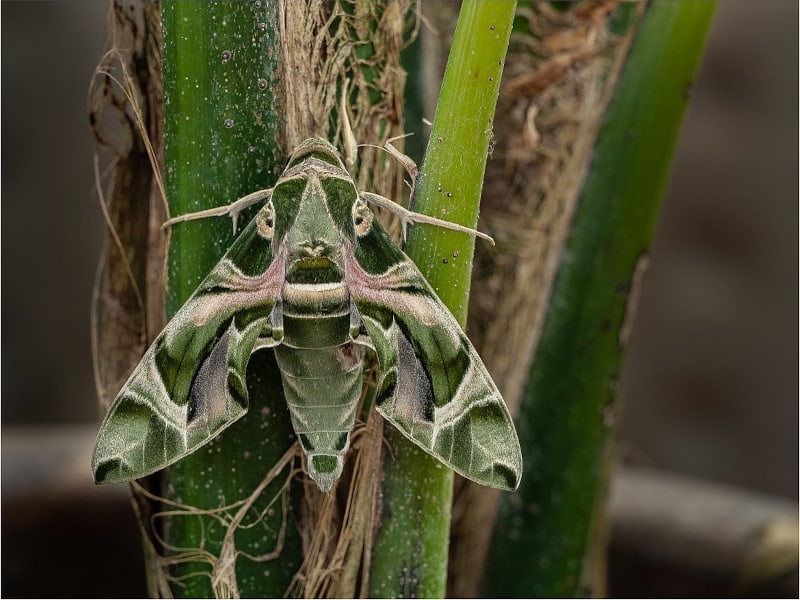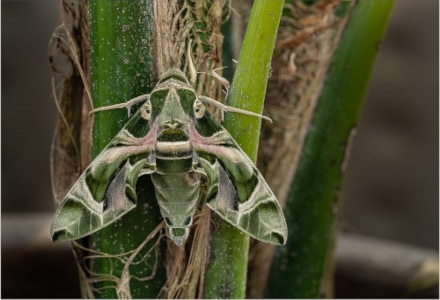
Army Green Moth Facts
- This magnificent creation of Nature and evolution frequently goes by the descriptive moniker of the Army Green Moth. That’s hardly the only term by which it’s known, though. It’s also referred to by the common name of the Oleander hawk-moth.
- Professionals, however, typically know it by yet another name. Thankfully, that’s a relatively simple term as such things go. That’s because in scientific circles it’s better known by its formal name of the Daphnis nerii. By either name, it’s a beautiful species.
- It further owes that specific technical name to the eminent Swedish botanist and zoologist Carl Linnaeus. That highly respected researcher recorded the first formal acknowledgement of the Arthropod as a separate and distinct species in the year 1758.
- The insect made its first appearance in scientific literature following that work. The renowned researcher included the newly recognized species in the 10th edition of his Systema Naturae. That appearance occurred in the same year as its acknowledgement.
- Most fortunately, the amazing Army Green Moth seems to be maintaining a population base that’s both stable and sizeable. In that respect it’s more fortunate than many of its relatives. The IUCN therefore currently has no listing for the creature on its Red List.
- The beautiful Lepidoptera nevertheless does face several potential threats to its own continued existence. These naturally include habitat loss due to human expansion. The wonder of Nature likely faces its greatest threat, however, in the form of climate change.
Related Articles
Army Green Moth Physical Description
The aptly-named Army Green Moth fully merits the degree of attention it receives from those lucky enough to encounter it. Although size is irrelevant to such things, it nonetheless impresses in that respect as well. That’s true since it’s far larger than many of its cousins.
It additionally distinguishes itself from the great majority of Lepidoptera in a surprising way. That’s because of something it does not display. That’s due to the fact that, unlike most moths and butterflies, it shows no noticeable degree of the trait of sexual dimorphism.
Individuals of both genders therefore manifest the same physical characteristics, including simple physical size. Remarkably, this insect attains a significant wingspan. Though this aspect varies between individuals, regardless of gender, it ranges from 3.5 – 5.1 in (9 – 13 cm).
Precise color patterns also vary from specimen to specimen, of course. Overall, however, this typically consists of a mosaic of olive and dark green backgrounds. Lighter cream colored streaks also run through the surface of the wings, and even such shades as violet.
Mature adult individuals, meanwhile, display a greenish head, with reddish-brown on the front and a grayish band on the reverse. The thorax also displays a green hue, with the collar outlined in gray. Distinctly, it also has a triangular gray patch present on the body’s top.
The abdomen of the Army Green Moth generally manifests a paler shade of green. Its forewings stand out due to a combined dark green background with both a black spot and a white patch at the base. The hindwings, though, usually appear somewhat darker in color.
- Kingdom: Animalia
- Phylum: Arthropoda
- Class: Insecta
- Order: Lepidoptera
- Family: Sphingidae
- Genus: Daphnis
- Species: D. nerii
Army Green Moth Distribution, Habitat, and Ecology
Fortunately, the fabulous Army Green Moth evolved as native to a remarkable broad swathe of the globe. It also tends to migrate significant distances, which places it in other parts of the world, as well. The natural marvel mainly appears natively across Africa and Asia.
From this home range, the intrepid Arthropod engages in regular migrations that take it to many connecting regions. This includes the southern and eastern portions of Europe in the summer. Individuals sometimes even travel as far to the north as parts of Scotland.
Probably due to actions of man, the invertebrate has also become naturalized to Hawaii, in the United States. In all the regions it appears, it displays marked habitat preferences. This holds true for both its primary and migratory range, as well as naturalized regions.
Given those areas of the globe, its preferences come as no surprise. Individuals make their home in warm relatively moist regions. Though not limited to, it often frequents areas of scrublands and highlands. In Hawaii, the Lepidoptera quickly adapted to tropical areas, too.
Like many of its relatives, this product of ages of evolution prefers regions with copious foliage. This instinctive tendency serves several purposes in its life cycle. These understandably include natural shelter as well food for the larval form of the insect.
That’s due to the fact that if further follows the pattern of its genetic cousins. The adults principally feed on the nectar of a wide variety of flowers, which such a habitat provides. Most nevertheless display a strong preference for honeysuckle, jasmine, and petunias.
The caterpillar form of the Army Green Moth, however, distinguishes itself. This holds true because of its diet. As its alternate common name implies, this form mainly consumes the oleander plant. Though highly toxic to most species, these caterpillars are immune.
Species Sharing Its Range
Check out our other articles on Fabulous Fungi Around the Globe, Black Mamba, Mount Kinabalu, Canary Island Date Palm, Pikachu Nudibranch, Wilson’s Bird-of-paradise, Chinese Giant Salamander, Snowshoe Hare

